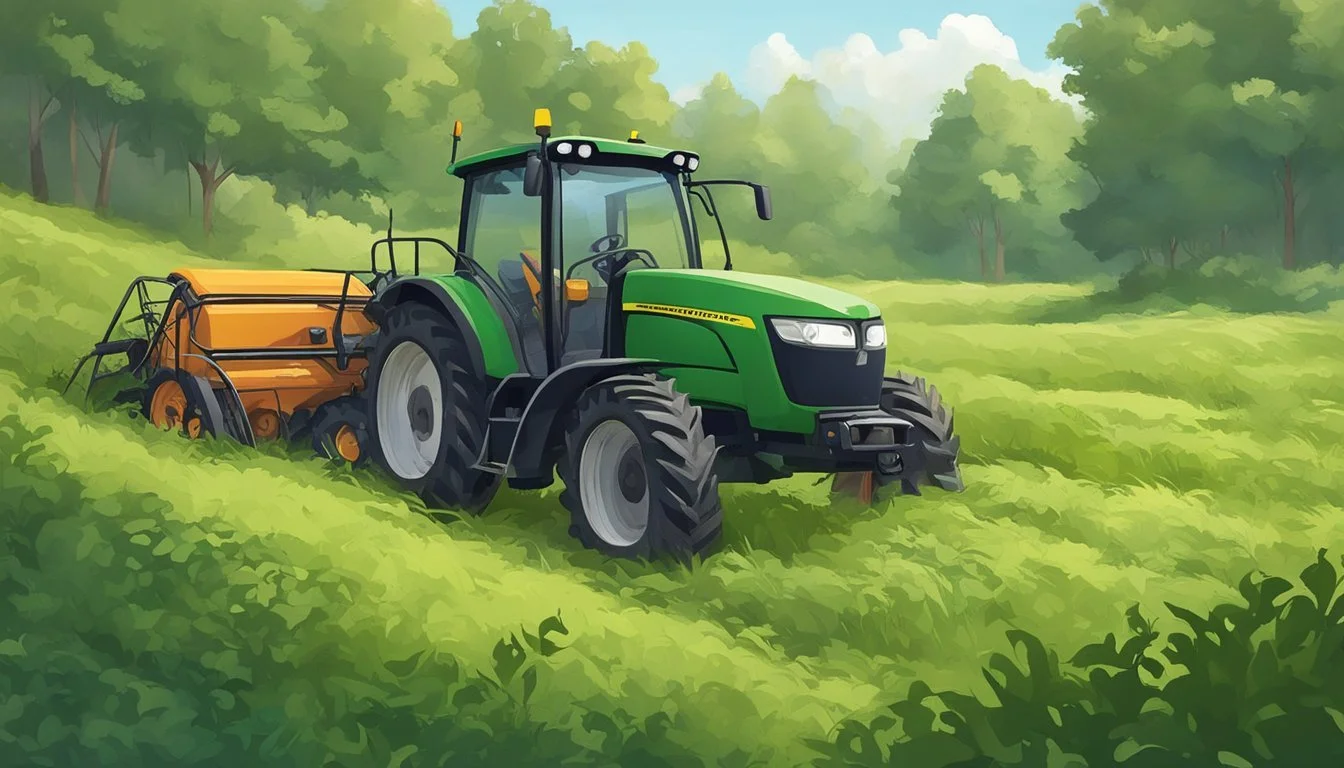How do I manage weedy or overgrown pastures?
Strategies for Reclaiming Your Grazing Land
Effectively managing weedy or overgrown pastures is crucial for maintaining the health and productivity of the land. Overgrazed or neglected pastures can become breeding grounds for a variety of weed species, which compete with desirable forage plants for sunlight, water, and nutrients. To reclaim the vitality of a pasture, it’s important to adopt a multi-faceted approach that includes identifying the types of weeds present, understanding their growth patterns, and implementing strategic control methods.
A key step in pasture management is striking a balance between grazing pressures and the pasture’s capacity to regenerate. Proper stocking rate management ensures pastures are not overgrazed, which can weaken forage plants and give weeds an advantage. Additionally, implementing a pasture rotation schedule can help to give different areas of the land time to recover, promoting healthy grass growth and reducing the opportunity for weeds to establish.
Mechanical removal, like hand-digging or burning, may be necessary for persistent weed problems. However, this approach can be labor-intensive and is often more practical for small areas or specific types of weeds. When weeds are widespread, herbicide application might be warranted. Yet, the timing and selection of herbicides are critical to avoid harming desirable pasture species while effectively targeting unwanted vegetation. In any control strategy, the long-term goal remains to foster robust grass growth that can outcompete weeds naturally, reducing the need for intervention over time.
Understanding the Pasture Ecosystem
Effective pasture management hinges on grasping the dynamic interactions within the pasture ecosystem. Key areas such as soil fertility, plant life cycles, and the impact of grazing are fundamental to maintaining a healthy and productive environment for livestock and plants alike.
Soil Fertility and pH Levels
Successful pasture management begins with a soil test to determine soil fertility and pH levels. Applying lime may be necessary to correct acidic soils, as the right pH balance is crucial for optimal fertility and forage yield.
Pasture Weeds and Plant Identification
Accurate weed identification is paramount, distinguishing between broadleaf weeds, pasture weeds, and essential forage grasses. Knowledge of weed species informs targeted weed management strategies, reducing infestations and supporting forage production.
Impact of Grazing on Pasture Health
Overgrazing depletes pasture health, while controlled grazing management maintains sufficient forage and minimizes weed proliferation. Stocking rate and grazing restrictions are tools to balance livestock needs with pasture sustainability.
Pasture Biodiversity and Plant Life Cycles
Understanding the life cycle of perennial weeds, annuals, and biennial weeds aids in developing timely weed control measures. Annual and biennial weeds like dandelion and thistles have specific growth patterns that can be strategically managed.
Roles of Beneficial Plants and Forage Quality
Grass and legumes contribute significantly to nutritional value, offering high nutritive value for livestock. Beneficial plants are integral to forage quality and should be promoted within the pasture ecosystem.
Understanding Weedy Infestations
Infestations can result from a number of factors, including inadequate seed establishment and poor grazing practices. Recognizing the early signs of infestations, such as the presence of Missouri's prolific ironweed or poison hemlock, is essential for timely intervention.
Livestock Health and Pasture Toxicity
Pasture toxicity is a grave concern when poisonous plants are present. Regular monitoring and consulting a veterinarian ensure livestock health is not compromised by these toxic species, such as Canada thistle.
Seasonal Variations and Weed Growth
Weed growth is influenced by seasonal variations; early spring weather conditions can favour certain weed types, including winter annuals and summer annual weeds. Timing of control measures must align with these seasonal patterns.
Local Ecosystem and Geographic Concerns
The local ecosystem and geographic concerns must be considered in pasture management. Localized weather patterns, soil types, and native flora and fauna all influence the selection of management practices that best suit the region, such as in areas known for problematic weeds like Missouri's dandelion or thistles.
Practical Pasture Management Techniques
Effective pasture management involves a combination of strategies to control weeds, promote soil health, and maintain robust forage growth. It's a multifaceted approach that integrates mechanical, chemical, and cultural methods along with a firm understanding of soil and plant science.
Mechanical Weed Control Methods
Mechanical methods such as mowing and tillage are instrumental in managing overgrown pastures. Mowing helps to cut down mature weeds, preventing seed production. Tillage is used to disrupt weed growth cycles and can prepare the land for reseeding.
Chemical Approaches to Weed Control
Chemical control involves the application of herbicides. Spot spraying of selective herbicides can target specific weed species, while non-selective herbicide application may be necessary for pervasive weed issues. It's crucial to follow label directions to avoid damage to desirable forage plants.
Grazing Strategies for Weed Suppression
The use of grazing animals can be a natural method of weed suppression. Implementing rotational grazing where animals are moved between pasture areas can prevent overgrazing and weaken weed species, integrating them into an overall weed management program.
Cultural Practices for Maintaining Healthy Pastures
Cultural practices such as proper seedbed preparation, adjusting planting rates, and using high-quality forage seed help in developing resilient pastures. These practices are the first line of defense in a pasture management system.
Renovation and Reseeding Techniques
For deteriorated pastures, renovation and reseeding may be necessary. Techniques include drill seeding or broadcasting seed to establish vigorous forage species that compete with weeds. It often follows weed control measures and soil preparation.
Soil Health and Amendment Procedures
Assessing soil health through a soil test is essential for determining necessary amendments such as lime to correct soil pH. Maintaining soil health is foundational for fertility and the nutritive value of pastures.
Fertility Improvement and Nutrient Management
Proper fertility through the use of fertilizers based on soil test recommendations ensures the forage has a high nutritional value. Balanced nutrient management supports vigorous pasture growth that can outcompete weeds.
Cost-Effective Management and Budget Planning
Implementing pasture management tactics must involve cost considerations for it to be sustainable. Planning a pasture management budget ensures that the chosen weed management strategies are financially viable without sacrificing effectiveness.
Advanced Weed Management and Control Strategies
To effectively manage weedy or overgrown pastures, farmers are turning to advanced management strategies and technologies that provide precise and targeted control. These involve the use of biological agents, integrated approaches that combine multiple tactics, and precision technology that tailors weed control measures to specific conditions.
Biological Control Agents and Their Usage
Biological control involves employing living organisms such as insects, mites, or even larger animals like goats, which feed on weeds and help reduce weed pressure. For example, certain types of beetles are used to control leafy spurge, a common invasive weed. Goats are known to efficiently graze on numerous weed species, aiding in weed management as they prefer broadleaf weeds over grasses, thus reducing weed competition.
Integrated Weed Management Practices
Integrated Weed Management (IWM) practices combine cultural, mechanical, biological, and chemical methods to manage weeds. This multifaceted approach aims at improving the pasture's health and reducing reliance on any single control method. Tactics include altering grazing patterns to disadvantage weeds and using strategic mowing to prevent weed seeding. Soil management, such as proper fertilization and seeding with competitive forage crops, is also crucial for reducing weed control challenges.
Precision Agriculture and Technology in Weed Suppression
Advancemed conents in precision agriculture and technology are revolutionizing pasture weed management. GPS-guided tractors, drones, and sensors are used to map weed infestations and deliver herbicides more efficiently. Variable-rate application technology ensures that herbicides are applied only where needed, which conserves resources and reduces environmental impact. Such technology plays a vital role in weed suppression, ensuring that pastures remain productive and ecologically balanced.
Monitoring, Assessment, and Ongoing Management
Effective pasture management requires continuous observation and adaptive strategies to ensure the land stays healthy and productive. Weed infestations can decrease forage quality and yield, but through vigilant monitoring and employing a variety of control measures, the longevity of the pasture can be extended.
Regular Assessment and Monitoring of Pasture Health
Regularly evaluating pasture conditions is essential for proactive weed management. This involves both visual inspections to identify the types and extent of weed presence and soil testing to ascertain nutrient levels and pH balance. Periodic assessments help in determining the impact of weeds on forage quality and yield, guiding the timing and selection of control measures.
Long-Term Strategies for Weed Suppression
Implementing strategic grazing management practices can naturally suppress weeds and prolong stand life. Rotational grazing, for example, allows forage plants to recover and outcompete weeds, improving overall pasture longevity. Thoughtful stocking rates ensure that grazing promotes pasture health without giving weeds the opportunity to establish.
Best Practices for Sustained Pasture Productivity
To sustain high levels of pasture productivity, management tactics should include both mechanical and chemical methods of weed control tailored to the specific species and extent of weed challenges. Combined with sound grazing management, these practices optimize forage availability and quality while maintaining ecological balance.
Seeking Expert Guidance from Extension Services
Engaging with extension services can provide invaluable support for pasture management. These experts offer tailored advice, up-to-date research, and management tactics that suit individual land conditions and challenges, ensuring informed decisions and effective weed control strategies are in place.
Environmental Considerations and Sustainability
Managing weedy or overgrown pastures requires a balance between effective weed control and environmental stewardship. Utilizing sustainable farming practices ensures the long-term health of the pasture ecosystem while minimizing adverse impacts on the surrounding environment.
Sustainable Farming Practices and Weed Management
Sustainable weed management in pastures involves a combination of tactics that reduce reliance on chemical herbicides. Strategies such as Integrated Weed Management (IWM) include the application of bioherbicides, which are derived from natural sources and pathogens that target weeds without harming the environment. It’s important to tailor these methods to specific types of weeds and consider the timing of application to ensure efficacy and reduce the risk of weed resistance.
Impact of Pasture Management on Surrounding Ecology
Effective pasture management has a direct impact on the local ecology. Overgrazing and neglect can lead to a proliferation of invasive weeds, which can outcompete native plants and alter the habitat for wildlife. Conversely, well-managed pastures can serve as a natural reservoir for biodiversity. Practices such as rotational grazing help maintain soil health and encourage a balance between grasses and other desirable plant species.
Stewardship and Conservation Efforts
A key component of managing pastures sustainably is to engage in conservation efforts preserving both soil quality and water resources. Some methods include using cover crops or maintaining buffer zones around water bodies to prevent erosion and nutrient runoff. Pasture stewards can also employ stale seedbed preparation, allowing weed seeds to germinate and then removing them before planting desired pasture species. This method controls weed populations while minimizing soil disturbance, fostering a healthy pasture ecosystem.
Addressing Specific Weed Challenges
Effective pasture management requires strategic approaches to dealing with aggressive weeds and brush, as well as targeted control to address the risks associated with poisonous and invasive species. These tactics are essential to maintain a healthy pasture and productive livestock grazing environment.
Managing Aggressive Weeds and Brush
Aggressive weeds and brush consume valuable space and resources, presenting serious competition to desirable forage plants. For example, creeping perennials with extensive rhizomes or underground roots can be particularly challenging. Long-term weed control involves regular monitoring and timely interventions. Methods such as mowing, strategic grazing, and the careful application of herbicides, as well as employing practices like soil improvement to encourage desirable plant growth, are critical. For instance, herbicides containing metsulfuron are noted for their effectiveness but must be applied with attention to timing to avoid negative impacts on desired forage.
Targeted Control of Poisonous and Invasive Species
Poisonous plants pose a serious threat to livestock health and must be managed diligently. Identifying these plants and understanding their growth habits is the first step in effective management. Once identified, control methods such as physical removal or spot treatment with herbicides can be applied to mitigate their presence in the pasture. Meanwhile, invasive species can quickly dominate a pasture environment, with their management often requiring a combination of mechanical, chemical, and cultural control tactics to keep them in check. For instance, early identification and intervention can prevent invasive species from establishing and spreading throughout the pasture.
Future Trends in Pasture Management
The landscape of pasture management is rapidly evolving, with advancements targeting efficient weed control and resilience to climatic variability. These innovations are essential for maintaining productive and sustainable pasture ecosystems.
Innovation in Weed Control Techniques
Emerging technologies in weed management are set to revolutionize how farmers tackle invasive plants in pastures. Precision agriculture tools, such as drones equipped with advanced sensors, are being developed to identify and target weeds with localized treatments, reducing the reliance on broad-spectrum herbicides. Furthermore, there is progress in the genetic modification of forage crops to resist specific weed pressures, allowing them to outcompete undesirable species.
Adapting to Climate Change and Weather Patterns
As climate change alters weather patterns, pasture management strategies must adapt accordingly. Predictive modeling tools are being refined to provide farmers with actionable insights into future weather scenarios. This aids in making informed decisions about seed selection, planting schedules, and irrigation. Moreover, research is focusing on breeding forage varieties that are more resilient to extreme weather, such as drought and flooding, to ensure steady pasture productivity.
The Role of Research in Pasture Agronomy
The future of pasture agronomy will greatly benefit from ongoing research into soil health and plant-microbe interactions. Identifying optimal combinations of forage species that enhance soil structure and nutrient cycling can lead to more robust pastures with a lower incidence of weeds. Additionally, the introduction of beneficial microbes that compete with or inhibit weed growth is a promising area of study. This symbiotic approach could lead to a reduced need for chemical weed control measures, aligning with sustainable agriculture practices.
Conclusion
Effective weed management in pastures necessitates a combination of strategies to promote a healthy forage ecosystem that suppresses weed growth.
Firstly, maintaining an appropriate stocking rate prevents overgrazing, ensuring a robust stand of desirable forage plants. Introducing a pasture rotation schedule is crucial as it allows forage to recover and compete effectively against weeds. Additionally, strategic grazing practices can be employed where livestock target weeds when they are palatable and nutritious, thereby reducing weed proliferation.
Mechanical methods, when feasible, like hand-digging or mowing, can reduce the weed seed bank. However, their labor-intensive nature often restricts their application to small or particularly problematic areas.
Where appropriate, prescribed burning can manage certain woody species and persistent weeds, but it must be done under controlled conditions and by knowledgeable individuals to ensure safety and effectiveness.
Investing in good seedbed preparation and high-quality forage seed also lays the groundwork for a competitive pasture. Fertilization should be matched to the needs of the desired forage and not the weeds.
For persistent or severe weed problems, chemical controls may be necessary. These should be used judiciously, following an integrated approach that considers the long-term health of the pasture ecosystem.
Effective weed management involves monitoring and adaptability, continually assessing the pasture's condition and responding accordingly. This multi-faceted approach supports sustainable pasture productivity and overall land health.





